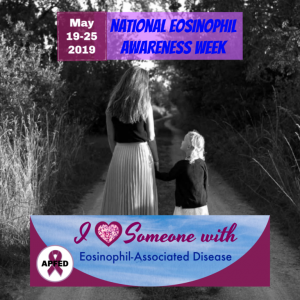Can you say EOSINOPHILIC? (E-O-sin-O-fill-ik)
Published by Feeding Matters on May 17, 2019
 The body’s immune system serves as its own internal ambulance, responding to crisis and triaging needs as they arise. Most times that rapid response works out just fine.
But sometimes, the immune system can turn on the body, or become a little too overzealous with its treatment to a perceived emergency, which can lead to other problems. An eosinophilic disorder is one of those.
Eosinophil-associated diseases are not only hard to pronounce, they are often difficult to diagnose due to a lack of awareness about the chronic digestive conditions. And that’s one of the reasons why National Eosinophil Awareness Week, held every year during the third week of May, is important.
At Feeding Matters, we’re acutely aware of how eosinophilic disorders impact the lives of those living with them, from children to adults. And we understand how challenging it can be to navigate, treat, and manage a chronic condition that affects eating and feeding.
Eosinophils are naturally-occurring white blood cells that, when they’re doing their jobs correctly, respond to allergy-triggering foods or allergens and release toxins to combat a reaction. But sometimes the body makes too many eosinophils.
When they build up, beyond the normal 5-percent volume of a person’s white blood cells, they trigger inflammation. And that leads to tissue damage.
Eosinophilic disorders are most often diagnosed in the esophagus, the stomach, the small and large intestines, or throughout the blood. Most eosinophilic disorders are endocrine or allergy-related and can affect the gastrointestinal, respiratory, and genitourinary tracts.
As one would expect, symptoms associated with eosinophilic disorders range based on where the inflammation and tissue damage is occurring. But, a number of common symptoms include difficulty swallowing, food getting stuck in the esophagus while eating, persistent heartburn, abdominal pain, vomiting, diarrhea, and nausea.
In children, eosinophilic disorders often result in a parent who experiences difficulty feeding and a child who has a difficult time eating. It is also noted that children who live with an eosinophilic disorder demonstrate a noticeable failure to thrive.
Due to the type of symptoms that come with eosinophilic disorders, it isn’t uncommon for those living with it to miss work or school.
While eosinophilic disorders are considered rare, it is an emerging problem worldwide and healthcare professionals are growing increasingly more aware of how the symptoms present themselves. Depending on the type of eosinophilic disorder, a diagnosis can come by way of a blood test, an endoscopy, or a biopsy of tissue. According to the American Academy of Allergy, Asthma and Immunology, physicians treat those diagnosed with an eosinophilic disorder by using a food elimination diet, corticosteroid medication to treat inflammation, and proton pump inhibitors to treat acid production in the stomach.
To learn more about eosinophilic disorders, how they impact the lives of those living with them, and how to manage chronic conditions associated with them, the American Partnership for Eosinophilic Disorders is a great resource.
The body’s immune system serves as its own internal ambulance, responding to crisis and triaging needs as they arise. Most times that rapid response works out just fine.
But sometimes, the immune system can turn on the body, or become a little too overzealous with its treatment to a perceived emergency, which can lead to other problems. An eosinophilic disorder is one of those.
Eosinophil-associated diseases are not only hard to pronounce, they are often difficult to diagnose due to a lack of awareness about the chronic digestive conditions. And that’s one of the reasons why National Eosinophil Awareness Week, held every year during the third week of May, is important.
At Feeding Matters, we’re acutely aware of how eosinophilic disorders impact the lives of those living with them, from children to adults. And we understand how challenging it can be to navigate, treat, and manage a chronic condition that affects eating and feeding.
Eosinophils are naturally-occurring white blood cells that, when they’re doing their jobs correctly, respond to allergy-triggering foods or allergens and release toxins to combat a reaction. But sometimes the body makes too many eosinophils.
When they build up, beyond the normal 5-percent volume of a person’s white blood cells, they trigger inflammation. And that leads to tissue damage.
Eosinophilic disorders are most often diagnosed in the esophagus, the stomach, the small and large intestines, or throughout the blood. Most eosinophilic disorders are endocrine or allergy-related and can affect the gastrointestinal, respiratory, and genitourinary tracts.
As one would expect, symptoms associated with eosinophilic disorders range based on where the inflammation and tissue damage is occurring. But, a number of common symptoms include difficulty swallowing, food getting stuck in the esophagus while eating, persistent heartburn, abdominal pain, vomiting, diarrhea, and nausea.
In children, eosinophilic disorders often result in a parent who experiences difficulty feeding and a child who has a difficult time eating. It is also noted that children who live with an eosinophilic disorder demonstrate a noticeable failure to thrive.
Due to the type of symptoms that come with eosinophilic disorders, it isn’t uncommon for those living with it to miss work or school.
While eosinophilic disorders are considered rare, it is an emerging problem worldwide and healthcare professionals are growing increasingly more aware of how the symptoms present themselves. Depending on the type of eosinophilic disorder, a diagnosis can come by way of a blood test, an endoscopy, or a biopsy of tissue. According to the American Academy of Allergy, Asthma and Immunology, physicians treat those diagnosed with an eosinophilic disorder by using a food elimination diet, corticosteroid medication to treat inflammation, and proton pump inhibitors to treat acid production in the stomach.
To learn more about eosinophilic disorders, how they impact the lives of those living with them, and how to manage chronic conditions associated with them, the American Partnership for Eosinophilic Disorders is a great resource.